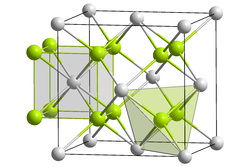Rubidium oxide
| Crystal structure | |||||||||||||||||||
|---|---|---|---|---|---|---|---|---|---|---|---|---|---|---|---|---|---|---|---|

|
|||||||||||||||||||
| Rb + : __ O 2− : __ | |||||||||||||||||||
| General | |||||||||||||||||||
| Surname | Rubidium oxide | ||||||||||||||||||
| Ratio formula | Rb 2 O | ||||||||||||||||||
| Brief description |
colorless crystals |
||||||||||||||||||
| External identifiers / databases | |||||||||||||||||||
|
|||||||||||||||||||
| properties | |||||||||||||||||||
| Molar mass | 186.93 g mol −1 | ||||||||||||||||||
| Physical state |
firmly |
||||||||||||||||||
| density |
3.72 g · cm -3 |
||||||||||||||||||
| Melting point |
400 ° C (decomposition) |
||||||||||||||||||
| solubility |
violent reaction with water |
||||||||||||||||||
| safety instructions | |||||||||||||||||||
|
|||||||||||||||||||
| As far as possible and customary, SI units are used. Unless otherwise noted, the data given apply to standard conditions . | |||||||||||||||||||
Rubidium oxide is an oxide of rubidium that reacts violently with water . It does not occur in nature.
properties
Rubidium oxide is a colorless, crystalline solid that turns yellow when heated. The salt crystallizes in an anti- calcium fluoride structure. The crystals are cubic with the space group Fm 3 m (space group no. 225) , the lattice parameter a = 674 pm and four formula units per unit cell . Rubidium oxide reacts violently with water:
The standard enthalpy of formation of rubidium oxide is ΔH f 0 = −331 kJ / mol.
When exposed to light, it slowly decomposes with a dark color.
Extraction and presentation
Rubidium oxide can be made by reacting rubidium and rubidium hydroxide :
further synthesis possibilities are:
and
such as
- .
In contrast, the direct reaction of rubidium and oxygen produces rubidium hyperoxide RbO 2 (mainly) or rubidium peroxide Rb 2 O 2 .
safety instructions
Since rubidium oxide reacts strongly with water, it acts as a base on the skin . When handling rubidium oxide, contact with the skin should therefore be avoided.
Individual evidence
- ↑ a b c d e f g Georg Brauer: Dialkalimonoxyde - Rubidiumoxyd . In: Handbook of Preparative Inorganic Chemistry . Ferdinand Enke Verlag, Stuttgart 1954, p. 738 .
- ↑ Registration dossier on Dirubidium oxide ( GHS section ) at the European Chemicals Agency (ECHA), accessed on July 12, 2020.
- ^ A b A. F. Holleman , E. Wiberg , N. Wiberg : Textbook of Inorganic Chemistry . 101st edition. Walter de Gruyter, Berlin 1995, ISBN 3-11-012641-9 , p. 1176.
- ^ Jean D'Ans, Ellen Lax: Pocket book for chemists and physicists. Volume 3: R. Blachnik (Ed.): Elements, inorganic compounds and materials, minerals. 4th revised and revised edition. Springer, Berlin et al. 1997, ISBN 3-540-60035-3 , p. 690 ( limited preview in the Google book search).
Web links
- Entry to rubidium oxide . In: P. J. Linstrom, W. G. Mallard (Eds.): NIST Chemistry WebBook, NIST Standard Reference Database Number 69 . National Institute of Standards and Technology , Gaithersburg MD






